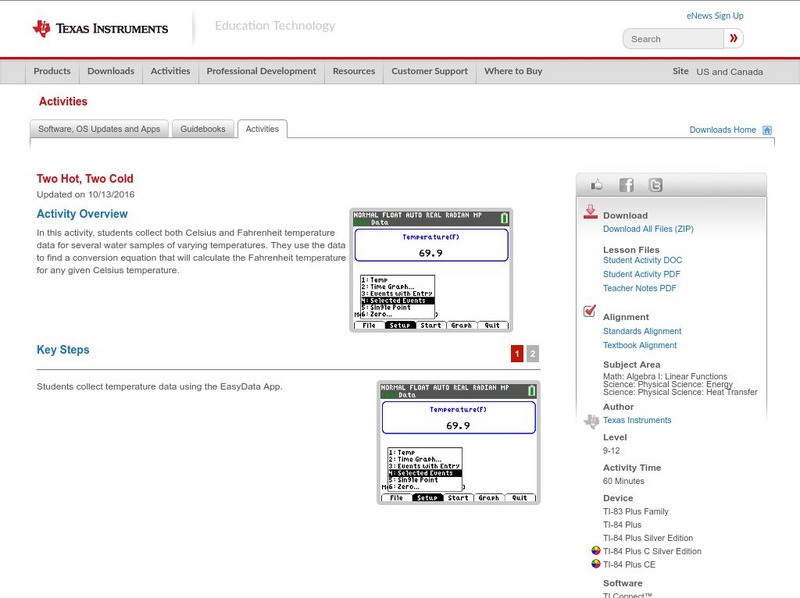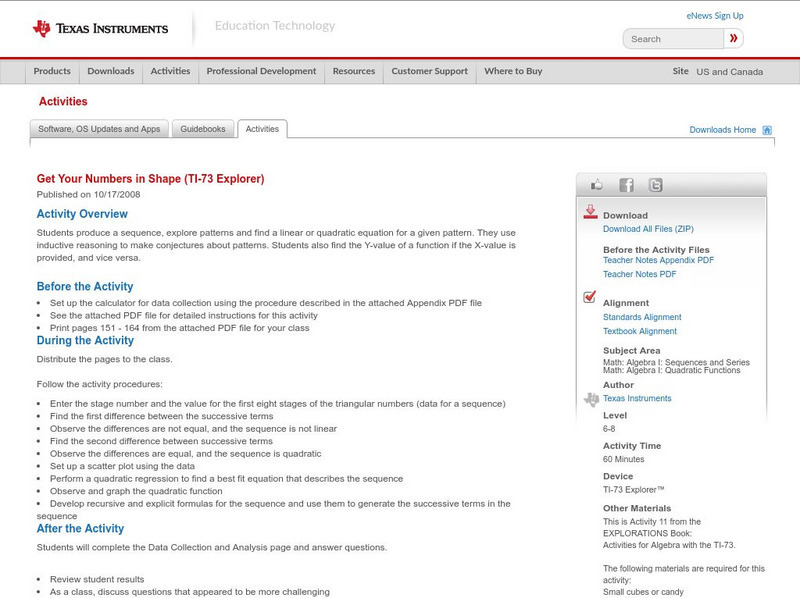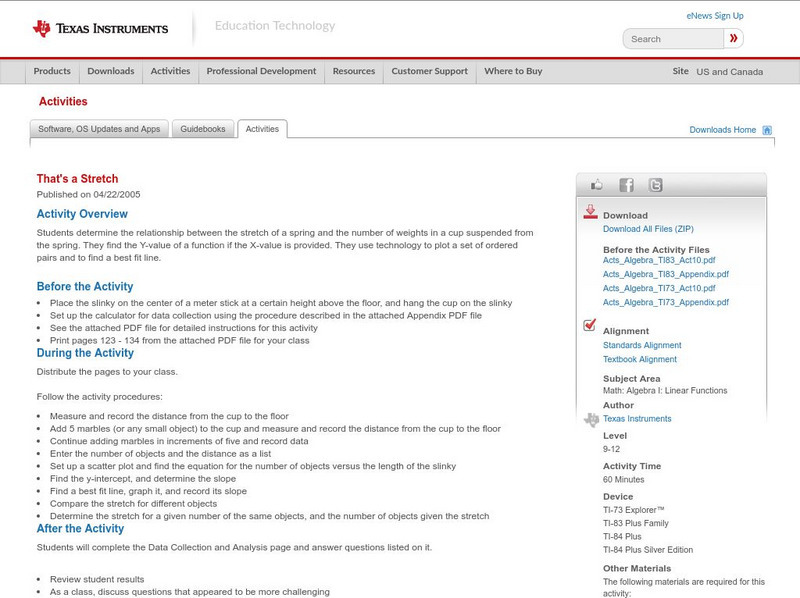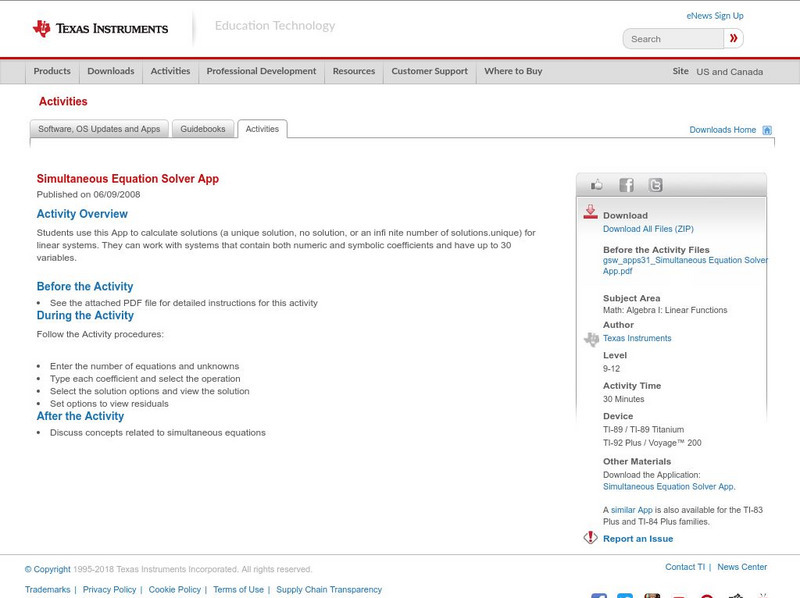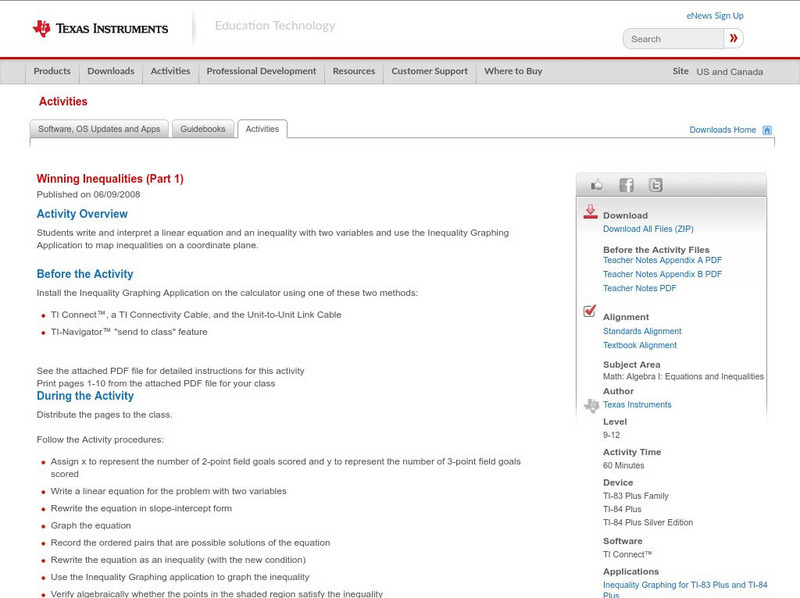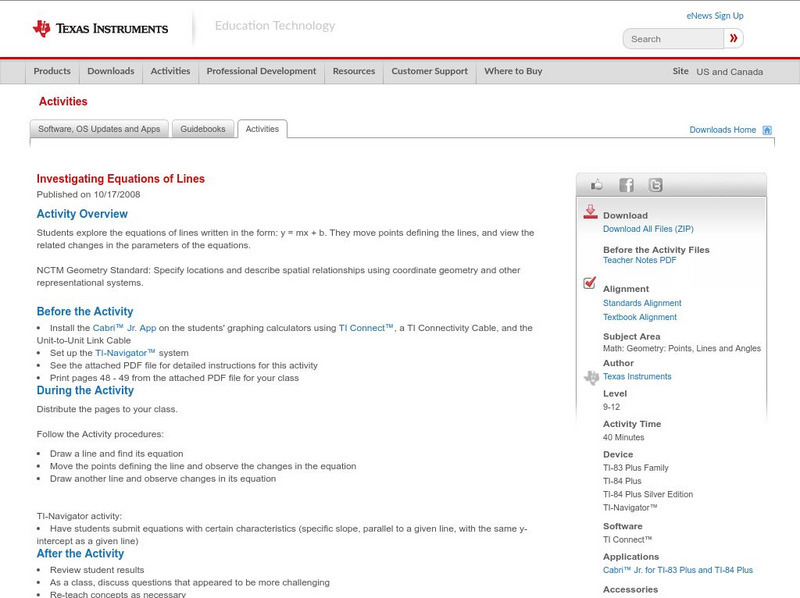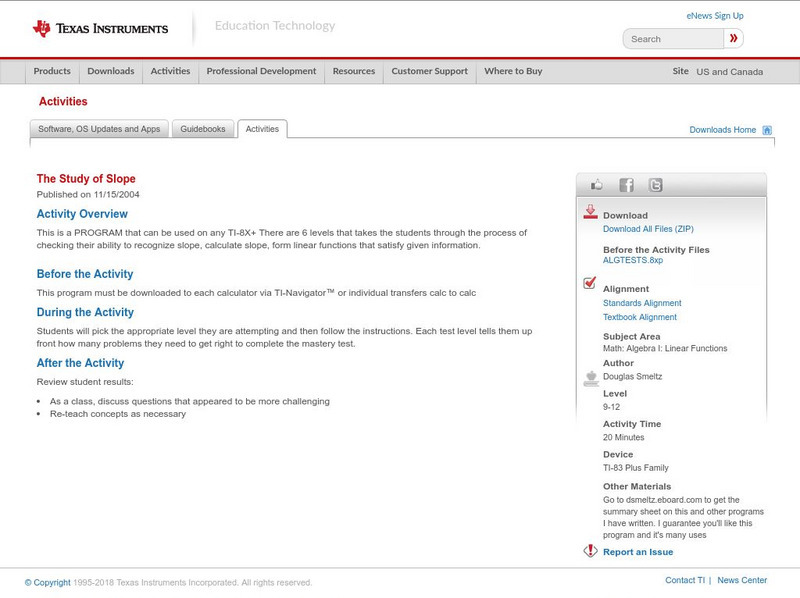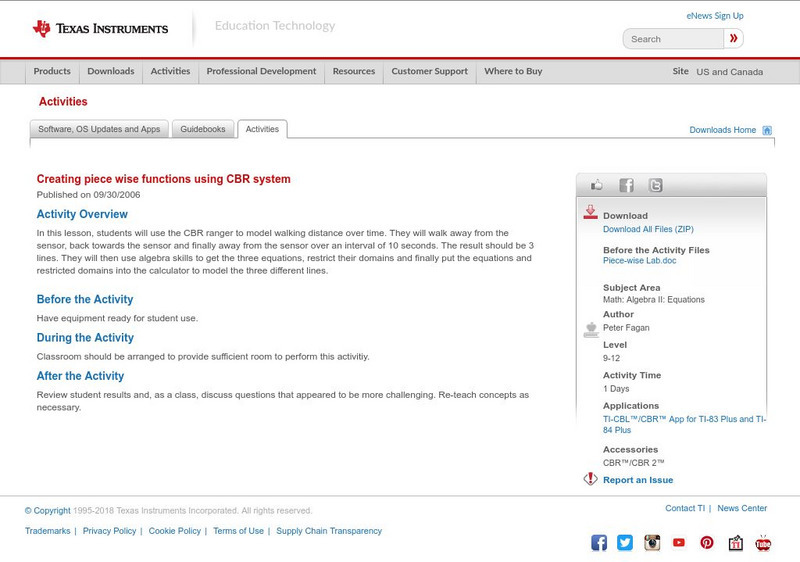Texas Instruments
Texas Instruments: Two Hot, Two Cold
In this activity, students collect both Celsius and Fahrenheit temperature data for several water samples of varying temperatures. They use the data to find a conversion equation that will calculate the Fahrenheit temperature for any...
Texas Instruments
Texas Instruments: Pyramid Slope
Students use their knowledge of linear equations to match a line to the edge of a pyramid image.
Texas Instruments
Texas Instruments: Slope Intercept Form
Students write linear equations in slope-intercept form and graph them. Students practice identifying slope and y-intercept and writing equations from a graphs.
Texas Instruments
Texas Instruments: Get Your Numbers in Shape
Students produce a sequence, explore patterns and find a linear or quadratic equation for a given pattern. They use inductive reasoning to make conjectures about patterns. Students also find the Y-value of a function if the X-value is...
Texas Instruments
Texas Instruments: That's a Stretch Ti 83
Students determine the relationship between the stretch of a spring and the number of weights in a cup suspended from the spring. They find the Y-value of a function if the X-value is provided. They use technology to plot a set of...
Texas Instruments
Texas Instruments: Numb3 Rs: Matrix Operations
Based off of the hit television show NUMB3RS, this lesson shows students how using matrix multiplication can lead to solving real-world problems. In this situation, a painting is missing and the probability of travel betweek five cities...
Texas Instruments
Texas Instruments: Simultaneous Equation Solver App
Students use this App to calculate solutions (a unique solution, no solution, or an infinite number of solutions.unique) for linear systems. They can work with systems that contain both numeric and symbolic coefficients and have up to 30...
Texas Instruments
Texas Instruments: Spring Thing: Newton's Second Law
In this activity, students' use a force sensor and a motion detector to collect force and acceleration data for an object moving up and down hanging from a spring. They use the data to test Newton's second law, and to estimate the mass...
Texas Instruments
Texas Instruments: Warming Up to Heating Curves
In this activity, students use the CBL 2 to collect temperature data as a sensor warms up in a cup of water. They find an appropriate mathematical model for the resulting data set.
Texas Instruments
Texas Instruments: Ball Bounce
This activity allows students to use real data obtained by them to model quadratic equations. students can use the TI-83 and/or TI-84 and a motion detector to collect their data. The students will then manually fit both quadratic and...
Texas Instruments
Texas Instruments: Velocity Test: Interpreting Velocity Graphs
In this activity, students' will use a motion detector to record the distance versus time data for the simple motion of a walker. They will calculate velocity from this graph and compare it with the velocity graph generated by the...
Texas Instruments
Texas Instruments: The World Population: Linear and Exponential Models
The population of the world has grown rapidly over the last century. In this activity, several models for the growth of the world's population will be developed. The validity of each in predicting past, current, and future populations...
Texas Instruments
Texas Instruments: Writing and Solving Systems of Equations Using Cabri Jr.
Through this introduction to the use of the Cabri Jr. application in the Algebra classroom, students will algebraically and graphically determine equations of lines, as well as determine solutions to systems of linear equations. Using...
Texas Instruments
Texas Instruments: Winning Inequalities (Part 1)
Students write and interpret a linear equation and an inequality with two variables and use the Inequality Graphing Application to map inequalities on a coordinate plane.
Texas Instruments
Texas Instruments: Investigating Equations of Lines
In this activity, students explore the equations of lines written in the form: y = mx + b. They move points defining the lines, and view the related changes in the parameters of the equations.
Texas Instruments
Texas Instruments: Systems of Equations in Algebra I
This activity will help students find solutions to systems of equations that they will see in Algebra I.
Texas Instruments
Texas Instruments: The Study of Slope
This is a PROGRAM that can be used on any TI-8X+ There are 6 levels that takes the students through the process of checking their ability to recognize slope, calculate slope, form linear functions that satisfy given information.
Texas Instruments
Texas Instruments: Tic, Toc: Pendulum Motion
In this activity, students' will use a motion detector to plot the position versus time graph for a swinging pendulum. They will determine the period of the motion and model the position data using a cosine function.
Texas Instruments
Texas Instruments: Tennessee Algebra I Gateway Learning Check Ii
Use this Learn Check at the beginning or end of class as a review for the TN Algebra I Gateway Exam.
Texas Instruments
Texas Instruments: Creating Piece Wise Functions Using Cbr System
In this lesson, students can use the CBR ranger to model walking distance over time. They will walk away from the sensor, back towards the sensor and finally away from the sensor over an interval of 10 seconds. The result should be 3...
Texas Instruments
Texas Instruments: "You're Hired!"
This activity will use linear programming and the Inequalz apps on the TI-84+ calculator to solve real world problems.
Texas Instruments
Texas Instruments: Take the Train
In this activity, students collect information about the stops made, time taken, and distance covered by a train on one of Amtrak's routes. They find a mathematical model that can best track the train. Students understand concepts...
Texas Instruments
Texas Instruments: Virginia Standards of Learning
Examples of questions from the Virginia SOLs
Texas Instruments
Texas Instruments: Ball Toss Activity
Students receive data from tossing a ball into the air. They are to graph it, set a window, and analyze the height, how long it was in the air, etc. They then find an equation that models the data.


